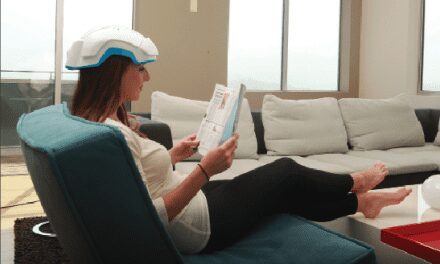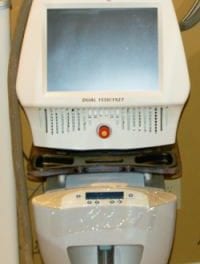A facial plastic surgeon and an oculoplastic surgeon practice together in a quest for superior results
 In their New York City practice, a husband–wife team of cosmetic surgeons strives to create the most natural-appearing, long-lasting results with the shortest recovery times possible. David B. Rosenberg, MD, a facial plastic surgeon, and Jessica Lattman, MD, an oculoplastic surgeon, practice their specialties individually. With increasing frequency, however, they combine their talents to care for individual patients.
In their New York City practice, a husband–wife team of cosmetic surgeons strives to create the most natural-appearing, long-lasting results with the shortest recovery times possible. David B. Rosenberg, MD, a facial plastic surgeon, and Jessica Lattman, MD, an oculoplastic surgeon, practice their specialties individually. With increasing frequency, however, they combine their talents to care for individual patients.
In these cases, the facial plastic surgeon and oculoplastic specialist benefit from each other’s expertise. Rosenberg and Lattman have gained tremendous advantages by working together, and sharing a medical office facilitates this relationship.
Lattman and Rosenberg have come together professionally through a shared passion for facial beauty. Both are dedicated to creating the most attractive surgical results without creating a postsurgical appearance. They consistently achieve this aesthetic ideal through a mastery of innovative surgical techniques, an artistic appreciation of ideal facial proportions, and an understanding of what the modern aesthetic-surgery patient seeks in facial rejuvenation.
Day to day, the surgeons function independently. They consult with and operate on their patients separately, and they develop their referral sources individually. Rosenberg, double board-certified in facial plastic surgery and otolaryngology–head and neck surgery dedicates his practice to aesthetic facial plastic surgery.
His areas of expertise include a modified version of the deep-plane facelift that he developed, the endoscopic brow lift with a multiple-point fixation system, blepharoplasty, and rhinoplasty. In addition, he routinely performs autologous fat transfer to the face, neck liposuction, chin implants, and skin resurfacing using lasers or chemical peels.
Lattman, a board-certified ophthalmologist with fellowship training in oculoplastic surgery, concentrates on aesthetic and reconstructive surgery around the eyes. Like Rosenberg, she routinely performs primary and secondary blepharoplasties, correction of malar bags, chemical peels, fat transfers, and brow lifts. She also frequently corrects upper-eyelid ptosis and lower-lid ectropion using reconstructive techniques. These surgical improvements of eyelid malpositioning not only restore the eyelids’ natural protective function, but also enhance facial symmetry and attractiveness.
Her talent with these methods is the reason that Rosenberg often recruits Lattman for the benefit of his patients. In addition, Lattman’s work includes reconstruction after excision of eyelid-skin cancers; repair of orbital fractures; and correction of entropion, ectropion, lacrimal-duct obstruction, and issues related to thyroid orbitopathy.
Combined Benefits

The subsequent surgery provides the patient with a more complete, symmetrical aesthetic outcome than Rosenberg could provide alone. Likewise, when a patient of Rosenberg requests lower blepharoplasty, but has excess lid laxity, Rosenberg recruits Lattman to perform the appropriate lid-tightening procedure.
The benefits of having an oculoplastic surgeon in the office also include nonsurgical ophthalmological care for Rosenberg’s patients. Lattman performs preoperative eye examinations and, when necessary, treats chronically dry eyes with appropriate drops or punctal plugs. Postoperatively, Lattman evaluates and treats persistently dry eyes and helps patients reintroduce contact lenses.
Lattman’s patients also benefit greatly from having Rosenberg in the office. Whereas Lattman’s expertise focuses on the eyes, many of her clients also desire rejuvenation of other facial areas. In these instances, Lattman recruits Rosenberg; together, the surgeons create an aesthetic-surgery plan.
Patients of Both Surgeons

Lattman performed a complete ophthalmological evaluation, with particular attention to upper-lid height, levator function, tear film, brow position, and visual fields. She assessed lower-lid position, snap-back ability, and margin distraction. She suggested an upper and lower blepharoplasty, a Fasanella–Servat procedure2 to correct the patient’s ptosis, and a tarsal-strip procedure with orbicularis muscle-suspension repair3 to improve lower-lid retraction.
In addition, Lattman concurred with Rosenberg that he should perform an endoscopic brow lift and deep-plane midface lift.4 The patient elected to undergo the proposed cosmetic and functional operations, and the case was scheduled.
Patient B (Figure 2) also desired facial-rejuvenation surgery. Rosenberg obtained the patient’s history and addressed complaints of sunken eyes and droopy cheeks. On physical examination, Rosenberg noted lower-lid laxity, midfacial descent, and loss of facial volume. Rosenberg suggested a deep-plane midface lift and referred the patient to Lattman for evaluation and treatment of the eyelid pathologies.
Lattman performed a complete evaluation (as described for patient A). She suggested lower blepharoplasty and fat transfer. The patient elected to undergo the proposed aesthetic and functional operations, and the case was scheduled.
Surgery Together
On the days of surgery for patients A and B, both Rosenberg and Lattman re-evaluated the patients’ faces and eyes at Manhattan Eye, Ear and Throat Hospital, New York City. They drew the necessary surgical markings while the patients were still awake. A board-certified anesthesiologist administered anesthesia, and a local anesthetic was infiltrated into the face to lessen the pain after surgery. The patients were then prepared and draped for surgery.
Lattman began the surgery with fat harvesting and transfer to the nasojugal groove (for patient B) and proceeded to upper-lid blepharoplasty, followed by ptosis repair using the Fasanella–Servat technique (for patient A). Next, she performed bilateral tarsal-strip procedures and lower-lid blepharoplasties. Upon completion of Lattman’s surgeries, Rosenberg carried out an endoscopic brow lift (for patient A) using a multiple-point soft-tissue fixation system. Subsequently, he performed bilateral deep-plane midface lifts for both patients using post-tragal incisions.
Excellent hemostasis was preserved throughout these cases, and no drains were required. Instead, conforming pressure dressings were applied for each patient’s first postoperative night. The patients awoke from anesthesia uneventfully and, after several hours of recovery, each went home with a companion. The following morning, Rosenberg made house calls to remove the dressings; 7 days later, all sutures were removed during office visits.
In conclusion, Rosenberg and Lattman agree that they are more formidable as a team. They feel capable of creating the most natural-appearing, beautiful faces—see the results in Figures 1 and 2—using the innovative surgical techniques that they have mastered. Every angle of the face is covered in their office. As Rosenberg notes, they strive for excellence in every case and, together, they reach that goal. PSP
David B. Rosenberg, MD, and Jessica Lattman, MD, are in private practice in New York City. Rosenberg is also a staff member of the Division of Facial Plastic Surgery, Manhattan Eye, Ear and Throat Hospital, New York City. Lattman is on the staff of the Department of Ophthalmology at the same hospital. Jenny Yee-Levin, RPAC, is Rosenberg’s physician assistant. The authors can be reached at (212) 832-8595 or [email protected].
References
1. Matarasso A. Buccal fat pad excision: Aesthetic improvement of the midface. Ann Plast Surg. 1991;26:413–418.
2. Howard GR. Management of acquired ptosis. In: Focal Points Clinical Modules for Ophthalmologists. Vol 17, no 8. San Francisco, Calif: American Academy of Ophthalmology; 1999:1–4.
3. Stewart WB. Surgery of the Eyelid, Orbit, and Lacrimal System. Vol 2. San Francisco, Calif: American Academy of Ophthalmology; 1994.
4. Hamra SR. The deep-plane rhytidectomy. Plast Reconstr Surg. 1990;86: 53–63.



